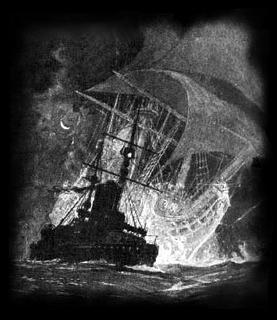
The Flying Dutchman is probably the best known ghost ship. Let’s take time today to dig into it’s many legends and see what we shall see…
The term 'Flying Dutchman' actually refers to the captain, not his ship. Legend has it that this maniacal Dutch sea captain was struggling to round the Cape of Good Hope in the teeth of a terrible gale that threatened to sink his ship and all aboard. The sailors warned him to turn around, the passengers pleaded, but the captain, either mad or drunk, refused to change course. Instead, he pressed on, singing loud and obscene songs, before going below to his cabin to drink beer and smoke his pipe. Monstrous waves pummeled the sides of the ship, howling winds bent the masts and tore at the sails, but still the captain held his course, challenging the wrath of God Almighty by swearing a blasphemous oath. Because of the captain's refusal to sail for safe harbor, the ship was lost and the captain and crew doomed to sail the seas forever. In some tellings of the legend a ghostly shadow appears on the deck and speaks to the captain.
"As a result of your actions,” says the shadow figure, “you are condemned to sail the oceans for eternity with a ghostly crew of dead men, bringing death to all who sight your spectral ship, and to never make port or know a moment's peace.”
The captain, reckless to the last, supposedly cried, "Amen to that!"
And so, for centuries from then on, the Flying Dutchman was seen piloting his spectral vessel, its canvas spread, its masts creaking in a fearful wind. Often, it was said, he led other ships astray, onto rocky shoals and hidden reefs. Also he was said to be responsible for turning sailors' food supplies sour. Those who saw the captain himself claimed that he was bareheaded and repentant, clasping the wheel on the quarterdeck, pleading the heavens for mercy at last. In the rigging of his ship, some said, they could see a crew of skeletons, grinning miserably as they put on ever more sail. The tale of the Flying Dutchman has been elaborated by many writers, but it is more than a piece of fiction. The phantom ship has been seen many times — and there have been reports even in the 20th century, including the crew of a German submarine boat during World War II.
On
It is said that the appearance of the Flying Dutchman is an omen of disaster and that it is seen most often during stormy weather. One of the first recorded sightings was by the captain and crew of a British ship in 1835. They recorded that they saw the phantom ship approaching in the blanket of a terrible storm. It came so close that the British crew feared the two ships might run into each other, but then the ghost ship suddenly vanished.
On
"A strange red light as of a phantom ship all aglow, in the midst of which light the mast, spars and sails of a brig 200 yards distant stood out in strong relief."
It was a misfortune that the lookout saw the Flying Dutchman, for soon after on the same trip, he accidentally fell from a mast and died. Fortunately for the English royal family, the young midshipman survived the curse.
As recently as March, 1939, the ghost ship was seen off the coast of South Africa by dozens of bathers who supplied detailed descriptions of the ship, although most had probably never seen a 17th century merchant vessel. The British South Africa Annual of 1939 included the story, derived from newspaper reports:
"With uncanny volition, the ship sailed steadily on as the Glencairn beach folk stood about keenly discussing the whys and wherefores of the vessel. Just as the excitement reached its climax, however, the mystery ship vanished into thin air as strangely as it had come."
One sighting in 1942 was off the coast of
Many authorities have argued that the story of the Flying Dutchman has its origin in a real event, though there is very little agreement about what the event was. Further confusion is brought into the matter by the fact that are many versions of the tale — in which the ship's skipper is variously named
Vanderdecken, Van Demien, Van Straaten, Van der Decken, or Van something else.
Another version of the legend that allegedly originated the whole affair is said to have happened in 1641, when a Dutch ship sank off the coast of the
thereby providing a welcome repose to ships at sea. He was so deep in thought that he did not notice the dark clouds looming and only when he heard the lookout scream out in terror, did he realize that they had sailed straight into a fierce storm. The captain and his crew battled for hours to get out of the storm and at one stage it looked like they would make it. Then they heard a terrible crunch — the ship had crashed into treacherous rocks and started to sink. As the ship plunged downwards, Captain Van der Decken (or whatever) knew that
death was approaching. He was not ready to die and screamed out a curse: "I WILL  round this
round this
And, like in every version of the tale, this one also claims that even today whenever a storm brews off the Cape of Good Hope, if you look into the eye of the storm, you will be able to see the ship and it's captain — The Flying Dutchman. Don't look too carefully, for the old folk claim that whoever sights the ship will die a terrible death.
In yet another version, this one placed in the year 1729 (others say 1680), the captain this time swears at the Devil, who then condemns him to sail the spectral seas forever. The Devil left him just one small hope; that only through the love of a woman could he be released from his curse. So the unfortunate Dutch captain returns to land every seven years in a hopeless search for salvation, because the Dutchman can only find eternal peace in the arms of a faithful woman. Wagner's opera, "Der fliegende Hollander," is loosely based on this version of the legend.
Phantom ships, whether observed one or more, can often be explained as optical illusions. For centuries mariners reported the sighting of ships sailing through the sky above the horizon, this turns out to be a simple mirage caused by the refraction of light rays. The Flying Dutchman legend may have originated in the account of a superstitious seaman who saw such a mirage but did not understand its nature. Or one of the origins suggested above may be true, who knows! It is just another in a growing number of reasons to keep walking in this big weird world of ours!
I’m Average Joe


No comments:
Post a Comment